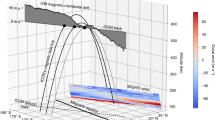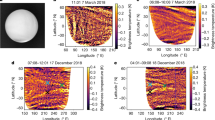Abstract
The installation of a Fabry–Perot interferometer at Halley (75.5° S, 26.8° W; L = 4.2), Antarctica, has now allowed the first comparison to be made between Southern Hemisphere ground-based thermospheric wind measurements and the predictions of a three-dimensional time-dependent thermospheric global circulation model. Because some terms of the thermospheric momentum equation are more dependent on geomagnetic than geographic latitude, the large separation of these that exists at Halley provides a distinct contrast to the dynamic behaviour observed in the more frequently studied northern polar thermosphere. Although the initial results from the experiment are in general agreement with the model, some consistent and significant differences between the observed wind field and that predicted are evident in the morning sector. These may be related to uncertainties in mapping magnetospheric boundaries to ionospheric heights in the Southern Hemisphere.
This is a preview of subscription content, access via your institution
Access options
Subscribe to this journal
Receive 51 print issues and online access
$199.00 per year
only $3.90 per issue
Buy this article
- Purchase on Springer Link
- Instant access to full article PDF
Prices may be subject to local taxes which are calculated during checkout
Similar content being viewed by others
References
Rees, D. et al. J. Geophys. 50, 202–211 (1982).
Killeen, T. L. et al. Geophys. Res. Lett. 11, 311–314 (1984).
Rees, D. J. Br. interplanet. Soc. 24, 233–246 (1971).
Rishbeth, H. J. atmos. terr. Phys. 34, 1–47 (1972).
Smith, R. W. in Exploration of the Polar Upper Atmosphere (eds Deehr, C. S. & Holtet, J. A.) 189–198 (Reidel, Dordrecht, 1980).
Kohl, H. & King, J. W. J. atmos. terr. Phys. 29, 1045–1062 (1967).
Fuller-Rowell, T. J. & Rees, D. J. atmos. Sci. 37, 2545–2567 (1980).
Hays, P. B. et al. J. geophys. Res. 89, 5597–5612 (1984).
Akasofu, S.-I. in Upper Atmospheric Research in Antarctica (eds Lanzerotti, L. J. & Park, C. G. 157–199 (American Geophysical Union, Washington, DC, 1978).
Rees, D. Adv. Space Res. 5, 267–282 (1985).
Spiro, R. W., Reiff, P. F. & Maher, L. J. J. geophys. Res. 87, 8215–8227 (1982).
Rees, D. et al. Planet. Space Sci. 31, 1299–1314 (1983).
Dudeney, J. R. & Piggott, W. R. in Upper Atmospheric Research in Antarctica (eds Lanzerotti, L. J. & Park, C. G.) 200–235 (American Geophysical Union, Washington, DC, 1978).
Mayaud, P. N. Geophysical Monograph 22 (American Geophysical Union, Washington, DC, 1980).
Author information
Authors and Affiliations
Rights and permissions
About this article
Cite this article
Stewart, R., Smith, R., Rees, D. et al. First measurements of thermospheric winds in Antarctica by an optical ground-based method. Nature 317, 45–47 (1985). https://doi.org/10.1038/317045a0
Received:
Accepted:
Issue Date:
DOI: https://doi.org/10.1038/317045a0
This article is cited by
-
Satellite Experiments Simultaneous with Antarctic Measurements (SESAME)
Space Science Reviews (1995)
-
Antarctica — A unique laboratory for atmospheric studies by optical methods
Surveys in Geophysics (1987)
Comments
By submitting a comment you agree to abide by our Terms and Community Guidelines. If you find something abusive or that does not comply with our terms or guidelines please flag it as inappropriate.



